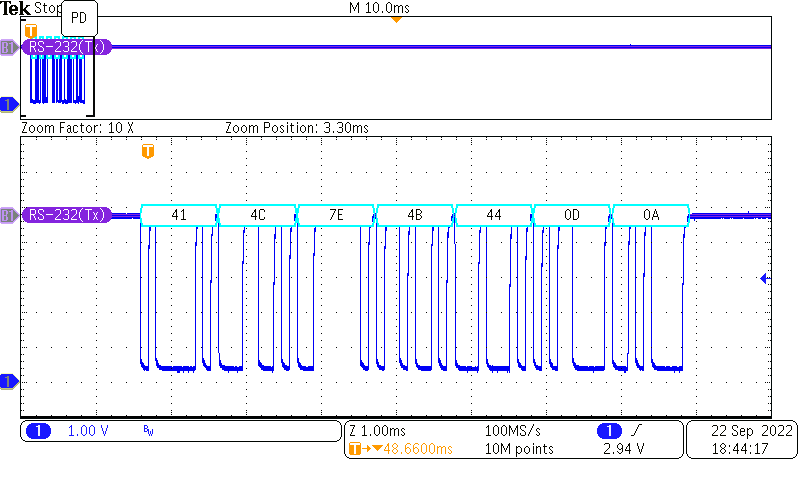KC is putting all of his energy into the Boondock Echo web interface. We have all basic features incorporated at this time. We can receive messages and push them to the server and pull messages from the server to transmit. KC is working on the web interface to add advanced features such as noise cancellation, speech-to-text, and more.
Should we win the prize, we plan to create a custom PCB that plugs into a handi-talkie and derives power from the audio connectors. However, there's no time to develop and iterate before final judging. Additionally, custom hardware hurts us here since we can achieve all our current goals with commercial off-the-shelf components for well under $100.
But since I'm not half the programmer KC is, there's not much for me to do in the source code modifications that wouldn't just slow KC down.
So I'm working on other roadmap features for the Boondock Echo. Future feature tackled last night was Remote tuning
Remote tuning
Baogeng-UV5R
Remote tuning of a Baofeng HT appears to be a non-trivial task. I can quickly open the HT radio and interface the keypad with a microcontroller, but that might be difficult to make a long-term solution, and there's an excellent chance it will void any FCC certification the radio has. There is no direct serial interface, but it might be possible to use a microcontroller as a device programmer through the speaker/microphone port. Then find out where in device memory the current frequency is stored and change it. Not terrifically difficult, but even if it is technically possible, it might require power cycling the HT, and it would take a little while to decode the memory bit map.
Anytone-778UVII
The Anytone-778UVII is an inexpensive ($129) 25 W mobile radio with an RJ-45 jack on the front that accepts a remote handset. The handset has 17 push buttons, a PTT switch, an up switch, a down switch, and a button lock. And since it's an RJ-45 plug/jack, it's trivial to listen in on communications between the handset and radio (tap pos 1 and 8). Once I probed and found the data pin and set the RS232 specs (9600, 8N), decoding took 10 minutes. Here's what the radio sends when you push the PTT

This is the most complicated data packet the handset has in it. 53 and 54 are the ASCII codes for "ST" or "Start Transmission". 04 is "EOT" or "End of Transmission", 07 is "BELL", etc. In short, they made this thing very, very easy to understand. I'll play with this a bit more when an antenna dummy load arrives. Right now, the radio detects the high SWR and shuts off immediately. I expect the radio keeps churning out 00 bytes to indicate continued transmission as long as the PTT button is pressed.
Each key is similarly easy to understand. A 7-byte data packet contains the packet header, data, and then Line Feed and Carriage Return

The key information is encoded in the 5th byte. And again, it couldn't be easier to understand. The programmers used the ASCII codes for each key 0-9, "/" for "A/B" button, "*" and "#" are the relevant ASCII codes for those characters, and "PA", "PB", "PC," and "PD" are just ASCII codes for "A", "B", "C", and "D" respectively.
| Button | Data stream from Handset | ||||||
| A/B | 41 | 4C | 7E | 4B | 2F | 0D | 0A |
| 0 | 41 | 4C | 7E | 4B | 30 | 0D | 0A |
| 1 | 41 | 4C | 7E | 4B | 31 | 0D | 0A |
| 2 | 41 | 4C | 7E | 4B | 32 | 0D | 0A |
| 3 | 41 | 4C | 7E | 4B | 33 | 0D | 0A |
| 4 | 41 | 4C | 7E | 4B | 34 | 0D | 0A |
| 5 | 41 | 4C | 7E | 4B | 35 | 0D | 0A |
| 6 | 41 | 4C | 7E | 4B | 36 | 0D | 0A |
| 7 | 41 | 4C | 7E | 4B | 37 | 0D | 0A |
| 8 | 41 | 4C | 7E | 4B | 38 | 0D | 0A |
| 9 | 41 | 4C | 7E | 4B | 39 | 0D | 0A |
| * | 42 | 4C | 7E | 4B | 2A | 0D | 0A |
| # | 43 | 4C | 7E | 4B | 23 | 0D | 0A |
| PA | 44 | 4C | 7E | 4B | 41 | 0D | 0A |
| PB | 45 | 4C | 7E | 4B | 42 | 0D | 0A |
| PC | 46 | 4C | 7E | 4B | 43 | 0D | 0A |
| PD | 47 | 4C | 7E | 4B | 44 | 0D | 0A |
So, to send a command to set the frequency to 442.675, you'd just send the following.
#41 #4C #7E #4B #34 #0D #0A #41 #4C #7E #4B #34 #0D #0A #41 #4C #7E #4B #32 #0D #0A #41 #4C #7E #4B #36 #0D #0A #41 #4C #7E #4B #37 #0D #0A #41 #4C #7E #4B #35 #0D #0A
I know that might look complicated, but from a microcontroller interface perspective, it's about as easy as you could hope for.
The Anytone 778UVII increases the overall cost of the project -- but it is a future development, and is still quite affordable. A radio, a battery, charger, Boondock Echo, and waterproof case should still come in under $250, which is rather affordable for all the given functionality.
 Mark J Hughes
Mark J Hughes
Discussions
Become a Hackaday.io Member
Create an account to leave a comment. Already have an account? Log In.